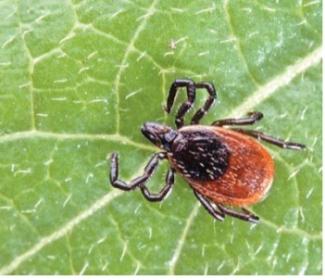Lyme disease has become more prevalent in Iowa in recent years, and since May is Lyme Disease Awareness Month, we would like to educate pet parents on what to watch out for and how to prevent it.
What Is Lyme Disease?
Lyme disease is a bacterial illness transmitted to humans, dogs, and other animals specifically by the deer tick.

When a tick bites a person or an animal, the bacterium gets transmitted to the recipient’s bloodstream. The most common symptoms of Lyme disease in dogs are:
- Lameness
- Swollen lymph nodes
- Joint swelling
- Fatigue
- Loss of appetite
The above symptoms typically occur at the chronic disease stage and as early as 2-5 months after infections, although signs can develop much later.
If Lyme disease is left untreated, symptoms can progress to kidney failure and even be fatal in severe cases. Serious neurological impacts and cardiac effects may also occur due to untreated Lyme disease.
Where Do Ticks Live?
You will most commonly find ticks outdoors in leaf litter, shrubs, or bushes. Ticks also exist in non-wooded areas. You can also find them in tall grasses. Ticks attach and cling on to passing animals. For this reason, it is essential to check your pet for ticks after you've spent any time outdoors. If you feel a small bump on your pet, be sure to part your pet's fur and take a closer look.
How to Remove Ticks from Pets
There are many old myths about how to remove ticks. Some people thought you could remove a tick by exposing it to heat. Another is dousing the tick with peppermint oil. Others believed that you had to twist the tick to get it out. These are neither safe nor effective methods.
For the safest method, watch the video from PetMD below.
How to Get Ticks Off Dogs: How to Kill a Tick and Remove the Head From Your Dog | PetMD
Lyme Disease Diagnosis and Treatment
We diagnose Lyme disease using a blood test that shows whether an animal has been exposed to the bacterium carried by the Deer Tick. If your dog is diagnosed with Lyme disease, we prescribe antibiotics which are typically administered for 30 days and usually provide effective treatment. However, following our advice regarding follow-up care is essential.
Lyme Disease in Iowa
The incidence of Lyme disease has more than tripled in Iowa since 2010. That does not mean that it has suddenly become common, but it is important to be cautious. Tick season runs from March to November. Iowa currently ranks 17th out of the 50 states for reported cases of Lyme disease.
Lyme Disease Prevention
The best treatment for Lyme disease is preventative treatment. Vaccination for Lyme disease and tick prevention are the best ways to keep your pet safe. Here are tips from the AVMA to help you prevent Lyme disease:
- Use reliable tick-preventive products. Please speak with us about what tick preventive product is right for your pet.
- When possible, avoid areas where you and your dog might come into contact with ticks. These include tall grasses, marshes, and wooded areas.
- Check for ticks on yourself and your animals once indoors after being outside.
- Clear shrubbery next to homes.
- Keep lawns well maintained.
- Vaccinate your pets. The Lyme vaccine is a series of 2 shots given 3 weeks apart. This is then boostered annually. The vaccine is proven safe an effective in prevention of Lyme disease.
Final Words
Here at Advanced Pet Care Clinic, we are big believers in prevention. Preventing an illness or disease is always better and easier than treating it, and Lyme disease is no exception. By following these prevention guidelines and staying vigilant, your pets can safely enjoy the beautiful outdoors.
Sincerely,
Dr. Tammy L. Stevenson

